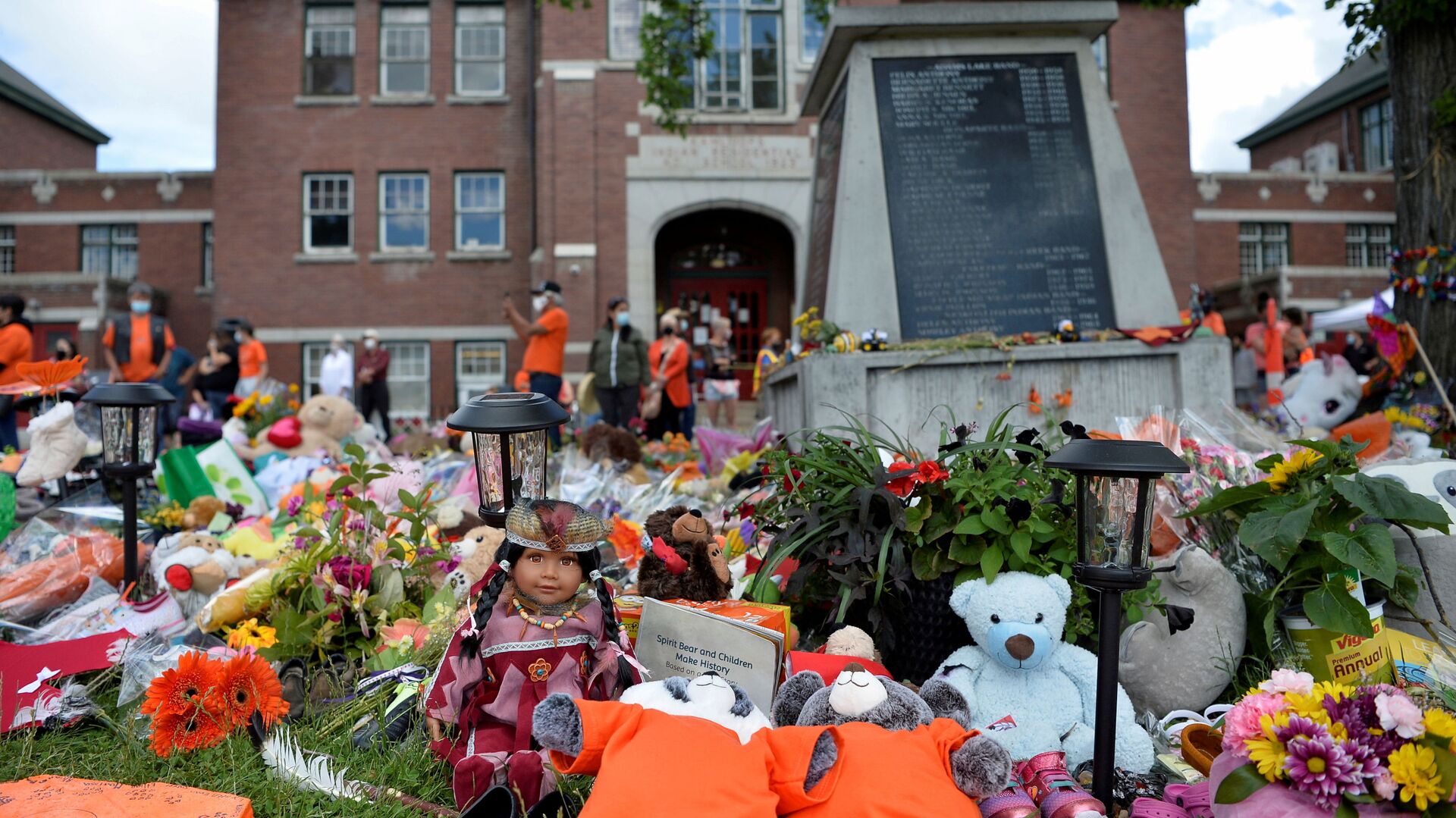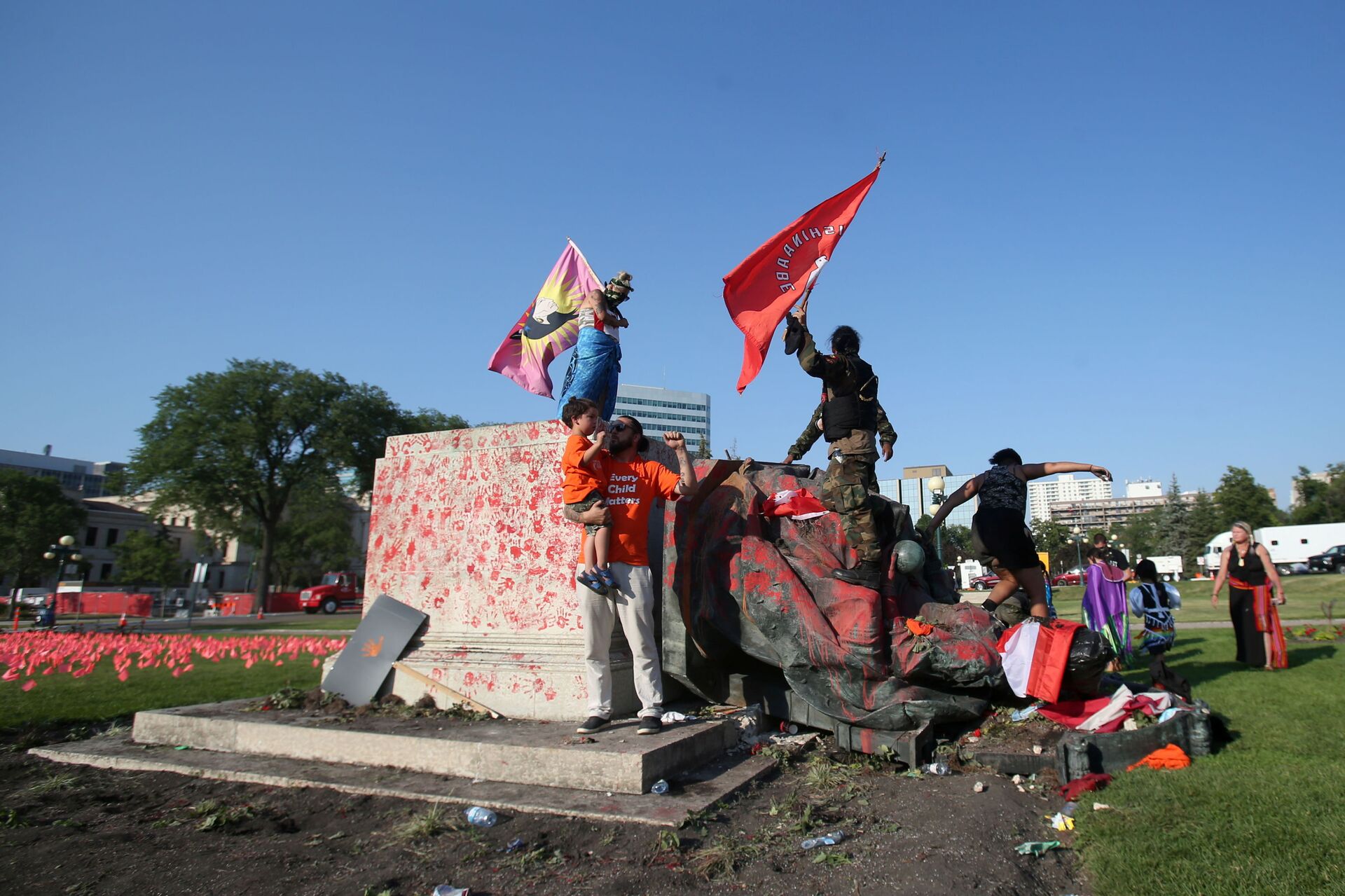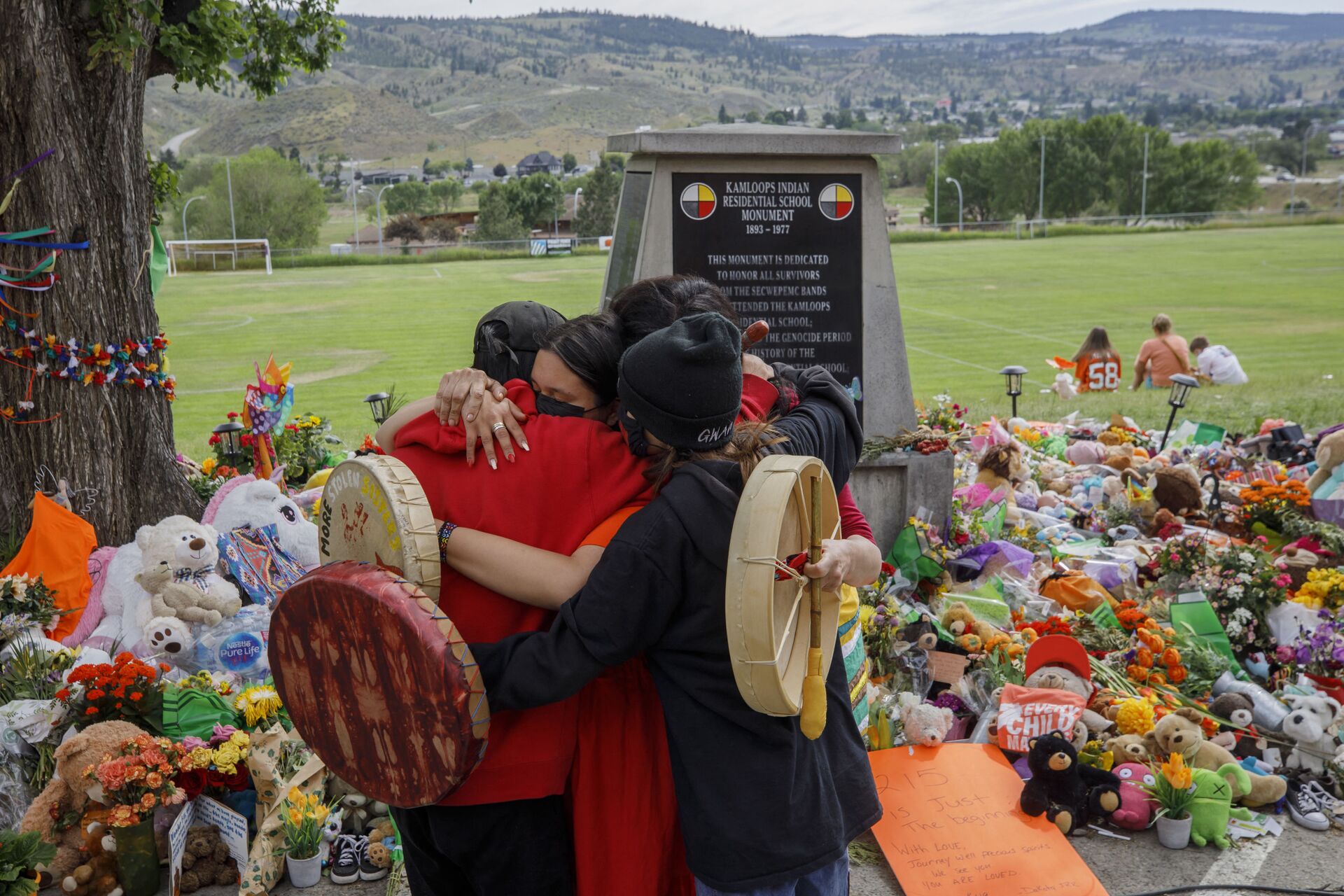Ex-UN Expert: Canada Residential Schools Just Part of 400-Year-Long Cultural Genocide of Natives
11:00 GMT 10.07.2021 (Updated: 11:01 GMT 26.10.2022)

© REUTERS / Jennifer Gauthier
Subscribe
Amid heated discussions about atrocities against aboriginal children in Canada, nothing has yet been done for the genuine rehabilitation of the discriminated-against indigenous peoples of North America, says retired UN independent expert Alfred-Maurice de Zayas.
Over the past two months hundreds of unmarked graves with childrens' remains were found at the sites of former Canadian forced assimilation schools, prompting a wave of public ire and criticism towards the Canadian government and Roman Catholic Church over the "cultural genocide" of the country’s indigenous peoples.
'Putting Band-Aids on Old Wounds'
"The outrage at the residential schools is justified, but this is too little too late," says retired UN Independent Expert on the Promotion of a Democratic and Equitable International Order Alfred-Maurice de Zayas. "It is like putting band-aids on old wounds, wounds that have not healed."
The Indian residential school system was a network of educational institutions aimed at forcibly assimilating indigenous children into Canadian society and civilising them. The network was funded by the Canadian government's Department of Indian Affairs with more than half of the entities operated by Christian churches between the 1870s and the 1990s. The last Indian residential school closed in 1996.
About 150,000 indigenous children were ripped from their parents and placed into residential schools, as Canada's Truth and Reconciliation Commission report found in 2015. First Nations, Inuit and Métis youngsters were forced to abandon their language, cultural beliefs, and way of life. To make matters worse, they were subjected to neglect, physical abuse, forced labour, malnutrition, inadequate health care, sexual assault and other atrocities. According to the official register 3,213 children are officially reported to have died in residential schools. Some believe the real number is much higher.

A crew performs a ground-penetrating radar search of a field, where the Cowessess First Nation said they had found 751 unmarked graves, near the former Marieval Indian Residential School in Grayson, Saskatchewan, Canada June 18, 2021.
© REUTERS / FSIN
Following the gruesome discoveries in May and June, a number of Catholic and Anglican churches were vandalised or set on fire across the country on Canada Day (1 July). The crowd of protesters toppled the monuments of Queen Victoria and Queen Elizabeth II in Winnipeg.
"Personally, I believe that removing statutes is only a symbolic act which does not provide any reparation or rehabilitation to the victims. Setting churches on fire is an aberration that must be investigated and prosecuted. It is not the fault of religion that the indigenous peoples of the US and Canada suffered, but the fault of the endemic racial policies of our governments. It is the duty of US and Canadian authorities today to apologise for the crimes and to take concrete measures to restore the indigenous to their human dignity" de Zayas notes.

A defaced statue of Queen Victoria lies after being toppled during a rally, following the discovery of the remains of hundreds of children at former indigenous residential schools, outside the provincial legislature on Canada Day in Winnipeg, Manitoba, Canada July 1, 2021.
© REUTERS / SHANNON VANRAES
'Genocide of Indigenous Populations'
The residential schools are but the last chapter in the four-century long process of deliberate destruction of indigenous cultures, according to the former UN expert.
"The abuses at the residential schools deserve national and international investigation, but in the context of much larger crimes, they constitute a marginal phenomenon," de Zayas notes. "Far more lethal than the enforced assimilation of indigenous children and the deliberate destruction of indigenous cultures and traditions, was the 'clash of civilisations' during the 17th, 18th, 19th and 20th centuries, featuring the physical destruction of indigenous groups, the burning of their homes, the massacres of women and children, the criminal land-grabbing, the looting of their natural resources."
The indigenous culture could not defend itself against the onslaught of land-hungry settlers, he highlights, adding that when indigenous groups tried to resist, they were mowed down.
"What is necessary is full rehabilitation of the indigenous of Canada, who endured aggression after aggression, and whose treaties with the Crown were violated before the ink was dry," argues de Zayas. "What is urgent is recognition of the magnitude of the crimes committed against indigenous."

Young dancers circle a statue of Queen Victoria, toppled during a rally, following the discovery of the remains of hundreds of children at former indigenous residential schools, outside the provincial legislature on Canada Day in Winnipeg, Manitoba, Canada July 1, 2021.
© REUTERS / SHANNON VANRAES
Referring to the ongoing outcry over systemic racism against black Americans and Canadians, the former UN official highlights that the fate of First Nations was far worse than that of the Afro-Americans in North America.
"The First Nations of the Continent were victims of genocide," de Zayas underscores. "Yes, genocide – although the term did not exist until 1948 when Professor Raphael Lemkin coined the word to refer to the ultimate crime, the ultimate expression of racism, the destruction of a people because they are different and because they occupied the lands and resources our ancestors coveted - and robbed. If there is a Black Lives Matter movement, it is perhaps even more urgent to launch an Indigenous Lives Matter movement – a Native Lives Matter consciousness."
Although the issue is largely neglected by the mainstream media, there are at least two meticulously documented books which shed extensive light on the problem, according to the scholar: one is dissertation by Tamara Starblanket, titled Suffer Little Children (Clarity Press 2018), and the other is the classic study on the destruction of the North American natives by Professor David Stannard, American Holocaust (Oxford 1992).

People from Mosakahiken Cree Nation hug in front of a makeshift memorial at the former Kamloops Indian Residential School to honour the 215 children whose remains have been discovered buried near the facility,
© AFP 2023 / COLE BURSTON
Ongoing Discrimination of Indigenous Populations in Canada
Discrimination against indigenous peoples in Canada is by no means a thing of the past; it is still going on. On 4 July 2014, UN Special Rapporteur on the rights of indigenous peoples James Anaya pointed out that the distressing socioeconomic conditions of Canada's First Nations outlined by his predecessor in 2004 remained largely unchanged. According to Anaya, the huge human development indicator gap between indigenous and non-indigenous Canadians in health care, housing, education, welfare and social services persisted.
In 2017, Brenda L. Gunn, an associate professor from University of Manitoba, published a study titled "Ignored to Death: Systemic Racism in the Canadian Healthcare System" which nailed widespread health disparities for Indigenous peoples in the country. One of the cases described by Gunn, was the story of Brian Sinclair, 45, a disabled indigenous man who died in the emergency department of Winnipeg’s Health Sciences Centre (HSC) in September 2008 after being ignored, unattended and uncared for thirty-four hours. Sinclair's problem was curable, he required a simple procedure and some antibiotics to treat a bladder infection and yet the indigenous man was left to die, Gunn underscored in her research.
"Back in 2015-16 when I was UN Independent Expert on the Promotion of a Democratic and Equitable International Order, I forwarded complaints from indigenous groups in Canada, expecting some frank debate," says de Zayas. "But no, I received an official ten-page answer – 9 pages of self-congratulation on how good Canadians are and how committed they are to human rights, and one page bottom line: the Declaration on the Rights of Indigenous Peoples is only a Declaration and therefore not binding, and the only 'hard law' in the field, ILO Convention 169 – well, Canada was careful NOT to ratify it. Yet another example of hypocrisy and double-standards."

Canada's Prime Minister Justin Trudeau puts on a face mask at Town Centre Park in Coquitlam, British Columbia, Canada July 8, 2021.
© REUTERS / JENNIFER GAUTHIER
Saying Sorry Isn't Enough
Over several past decades some leaders issued an official apology to the natives, de Zayas notes, stressing that it's not enough.
"In 1993 Bill Clinton issued an official US apology to the Hawaiian natives – words without any effort at rehabilitation or compensation," he says. "In 2009 Barack Obama issued an apology to the American 'Indians' – a tree fell in the forest and nobody heard it. The media gave it zero attention, and it is hard to find the document on the internet. It was the hypocritical gesture of a conqueror who wants to preserve the conquests – and not give anything back."
According to de Zayas, in fact, the United States and Canada should both submit specific indigenous practices and traditions to UNESCO to be included in the list of intangible world heritage of mankind. He insists that it is necessary to organise and properly finance an "Indigenous Lives Matter" movement which will demand a strategy, consistent with the constitution of UNESCO, to revitalise the uniqueness of the indigenous culture, before it's too late. Given that last summer Black Lives Matter Global Network Foundation managed to solicit $90 million in the United States during protests over George Floyd's death, it does not appear too hard to raise money for saving precious indigenous heritage. The only question is whether American or Canadian politicians are interested.
"In 2007 the Australian Prime Minister Kevin Rudd issued an apology to the Aborigines, some 99% of whom had perished under British rule," says de Zayas. "At least the gesture was followed by the return of large tracks of land to the Aborigines, including Kakadu and Uluru. What will Canada do?"



